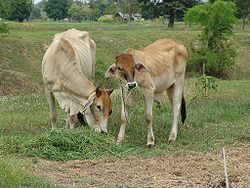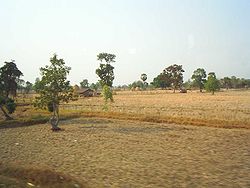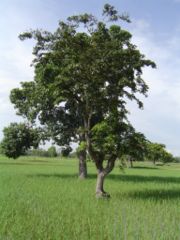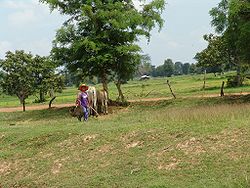
Economy of Isan
Encyclopedia

Agriculture
Agriculture is the cultivation of animals, plants, fungi and other life forms for food, fiber, and other products used to sustain life. Agriculture was the key implement in the rise of sedentary human civilization, whereby farming of domesticated species created food surpluses that nurtured the...
, although output is poor and this sector is decreasing in importance at the expense of trade
Trade
Trade is the transfer of ownership of goods and services from one person or entity to another. Trade is sometimes loosely called commerce or financial transaction or barter. A network that allows trade is called a market. The original form of trade was barter, the direct exchange of goods and...
and the service sector. Most of the population is poor and badly educated. Many labourers have been driven by poverty
Poverty
Poverty is the lack of a certain amount of material possessions or money. Absolute poverty or destitution is inability to afford basic human needs, which commonly includes clean and fresh water, nutrition, health care, education, clothing and shelter. About 1.7 billion people are estimated to live...
to seek work in other parts of Thailand
Thailand
Thailand , officially the Kingdom of Thailand , formerly known as Siam , is a country located at the centre of the Indochina peninsula and Southeast Asia. It is bordered to the north by Burma and Laos, to the east by Laos and Cambodia, to the south by the Gulf of Thailand and Malaysia, and to the...
or abroad.
Although Isan
Isan
Isan is the northeastern region of Thailand. It is located on the Khorat Plateau, bordered by the Mekong River to the north and east, by Cambodia to the southeast and the Prachinburi mountains south of Nakhon Ratchasima...
accounts for around a third of Thailand’s population and a third of its area, it produces only 8.9% of GDP
Gross domestic product
Gross domestic product refers to the market value of all final goods and services produced within a country in a given period. GDP per capita is often considered an indicator of a country's standard of living....
. Its economy grew at 6.2% per annum during the 1990s.
Sectors
Agriculture is the biggest sector of the economy. The following table shows the percentage of Gross Regional Product (GRP) by sector in 2000:{|
| Agriculture
| 21.9
|-
| Trade
| 17.9
|-
| Industrial
| 16
|-
| Services
| 14.8
|-
| Public administration and defence
| 7
|-
| Construction
| 4.1
|-
| Other
| 18.3
|-
|}
Agriculture




Agriculture
Agriculture is the cultivation of animals, plants, fungi and other life forms for food, fiber, and other products used to sustain life. Agriculture was the key implement in the rise of sedentary human civilization, whereby farming of domesticated species created food surpluses that nurtured the...
remains the largest sector of the economy, but its importance is decreasing. Its share of GRP fell from 45% in 1980 to 33.2% in 1990, and to 21.9% in 2000. During the 1990s, the agricultural sector grew at only 3.8% per annum, compared to 9.7% pa for the service sector. Although 76% of the population engages in some form of agriculture, only 46% of the workforce is formally employed in the sector, reflecting the fact that for many it is a part-time occupation.
Of the region's 62000 square miles (160,579.3 km²), only 35,600 is cultivated, and only 3000 is irrigated
Irrigation
Irrigation may be defined as the science of artificial application of water to the land or soil. It is used to assist in the growing of agricultural crops, maintenance of landscapes, and revegetation of disturbed soils in dry areas and during periods of inadequate rainfall...
http://www.ide.go.jp/English/Publish/Books/Asedp/pdf/066_cap6.pdf. There are a number of reasons for this. Saline
Salt
In chemistry, salts are ionic compounds that result from the neutralization reaction of an acid and a base. They are composed of cations and anions so that the product is electrically neutral...
contamination makes a third of the land unfit for cultivation. Although average rainfall is not much less than in other parts of the country, its unpredictability often causes drought
Drought
A drought is an extended period of months or years when a region notes a deficiency in its water supply. Generally, this occurs when a region receives consistently below average precipitation. It can have a substantial impact on the ecosystem and agriculture of the affected region...
or flood
Flood
A flood is an overflow of an expanse of water that submerges land. The EU Floods directive defines a flood as a temporary covering by water of land not normally covered by water...
ing. The latter is worsened by the generally flat terrain of the plateau
Plateau
In geology and earth science, a plateau , also called a high plain or tableland, is an area of highland, usually consisting of relatively flat terrain. A highly eroded plateau is called a dissected plateau...
, while both are exacerbated by the sand
Sand
Sand is a naturally occurring granular material composed of finely divided rock and mineral particles.The composition of sand is highly variable, depending on the local rock sources and conditions, but the most common constituent of sand in inland continental settings and non-tropical coastal...
y soil
Soil
Soil is a natural body consisting of layers of mineral constituents of variable thicknesses, which differ from the parent materials in their morphological, physical, chemical, and mineralogical characteristics...
, which is poor at retaining water. Deforestation
Deforestation
Deforestation is the removal of a forest or stand of trees where the land is thereafter converted to a nonforest use. Examples of deforestation include conversion of forestland to farms, ranches, or urban use....
reduced forest
Forest
A forest, also referred to as a wood or the woods, is an area with a high density of trees. As with cities, depending where you are in the world, what is considered a forest may vary significantly in size and have various classification according to how and what of the forest is composed...
cover from 25% in 1975 to 14% in 1995, again inhibiting water retention.
Attempts to improve the agricultural sector through irrigation and diversification have caused unforeseen environment
Natural environment
The natural environment encompasses all living and non-living things occurring naturally on Earth or some region thereof. It is an environment that encompasses the interaction of all living species....
al damage. Increased irrigation has increased the water table
Water table
The water table is the level at which the submarine pressure is far from atmospheric pressure. It may be conveniently visualized as the 'surface' of the subsurface materials that are saturated with groundwater in a given vicinity. However, saturated conditions may extend above the water table as...
in some areas, bringing salt to the surface and contaminating the soil. The same effect has also been observed following forest
Forest
A forest, also referred to as a wood or the woods, is an area with a high density of trees. As with cities, depending where you are in the world, what is considered a forest may vary significantly in size and have various classification according to how and what of the forest is composed...
clearance and the planting of cereal
Cereal
Cereals are grasses cultivated for the edible components of their grain , composed of the endosperm, germ, and bran...
crops, cassava
Cassava
Cassava , also called yuca or manioc, a woody shrub of the Euphorbiaceae native to South America, is extensively cultivated as an annual crop in tropical and subtropical regions for its edible starchy tuberous root, a major source of carbohydrates...
and sugar cane.
Irrigation has also proved somewhat ineffective in increasing agricultural production. Workers commonly work in agriculture during the wet season and turn to non-farm activities during the dry season. Using irrigation to increase dry season production would therefore reduce the labour devoted to these other activities and so reduce the income they provide, rather than simply supplementing it http://www.nectec.or.th/thai-yunnan/24.html.
The land which is cultivated is relatively unproductive: paddy fields produce only 424 tonne
Tonne
The tonne, known as the metric ton in the US , often put pleonastically as "metric tonne" to avoid confusion with ton, is a metric system unit of mass equal to 1000 kilograms. The tonne is not an International System of Units unit, but is accepted for use with the SI...
s of rice
Rice
Rice is the seed of the monocot plants Oryza sativa or Oryza glaberrima . As a cereal grain, it is the most important staple food for a large part of the world's human population, especially in East Asia, Southeast Asia, South Asia, the Middle East, and the West Indies...
per square mile, compared to 547 nationally. Many farmers still use water buffalo rather than tractor
Tractor
A tractor is a vehicle specifically designed to deliver a high tractive effort at slow speeds, for the purposes of hauling a trailer or machinery used in agriculture or construction...
s.
60% of cultivated land is devoted to paddy. The concentration on rice farming has made the farmers vulnerable to fluctuating prices, although this has now been reduced somewhat by increased diversification. Other crops produced include, tobacco
Tobacco
Tobacco is an agricultural product processed from the leaves of plants in the genus Nicotiana. It can be consumed, used as a pesticide and, in the form of nicotine tartrate, used in some medicines...
, cotton
Cotton
Cotton is a soft, fluffy staple fiber that grows in a boll, or protective capsule, around the seeds of cotton plants of the genus Gossypium. The fiber is almost pure cellulose. The botanical purpose of cotton fiber is to aid in seed dispersal....
and watermelon
Watermelon
Watermelon is a vine-like flowering plant originally from southern Africa. Its fruit, which is also called watermelon, is a special kind referred to by botanists as a pepo, a berry which has a thick rind and fleshy center...
s.
Other sectors
Other sectors of the economy have been growing more quickly than agriculture, although this growth can be misleading. The number of factories grew from 1908 in 1975 to 44,000 in 1995, but 34,312 of these were rice mills. In 2000, 76% of factories in Isan were breweries or food or tobacco processors.Poverty
Isan’s economic disadvantages have caused great poverty. In 1995, 28% of the population was classed as below the poverty line, compared to just 7% in Central Thailand. In 2000, per capitaPer capita
Per capita is a Latin prepositional phrase: per and capita . The phrase thus means "by heads" or "for each head", i.e. per individual or per person...
income
Income
Income is the consumption and savings opportunity gained by an entity within a specified time frame, which is generally expressed in monetary terms. However, for households and individuals, "income is the sum of all the wages, salaries, profits, interests payments, rents and other forms of earnings...
was just 26,317 baht, compared to 208,434 in Bangkok
Bangkok
Bangkok is the capital and largest urban area city in Thailand. It is known in Thai as Krung Thep Maha Nakhon or simply Krung Thep , meaning "city of angels." The full name of Bangkok is Krung Thep Mahanakhon Amon Rattanakosin Mahintharayutthaya Mahadilok Phop Noppharat Ratchathani Burirom...
. Even within Isan, there is a rural
Rural
Rural areas or the country or countryside are areas that are not urbanized, though when large areas are described, country towns and smaller cities will be included. They have a low population density, and typically much of the land is devoted to agriculture...
/urban
Urban area
An urban area is characterized by higher population density and vast human features in comparison to areas surrounding it. Urban areas may be cities, towns or conurbations, but the term is not commonly extended to rural settlements such as villages and hamlets.Urban areas are created and further...
divide. In 1995, all of Thailand's ten poorest provinces were in Isan, the poorest being Sisaket
Sisaket Province
Sisaket , is one of the north-eastern provinces of Thailand. Neighboring provinces are Surin, Roi Et, Yasothon and Ubon Ratchathani. To the south it borders Oddar Meancheay and Preah Vihear of Cambodia.-Geography:...
. However, most wealth and investment
Investment
Investment has different meanings in finance and economics. Finance investment is putting money into something with the expectation of gain, that upon thorough analysis, has a high degree of security for the principal amount, as well as security of return, within an expected period of time...
is concentrated in the four major cities of Khorat
Khorat
Khorat can refer to*the informal name of Nakhon Ratchasima town or Nakhon Ratchasima Province*the Khorat Sub-district in Sung Noen District of Nakhon Ratchasima Province...
, Ubon, Udon
Udon
is a type of thick wheat-flour noodle of Japanese cuisine.Udon is usually served hot as noodle soup in its simplest form as kake udon, in a mildly flavoured broth called kakejiru which is made of dashi, soy sauce , and mirin. It is usually topped with thinly chopped scallions...
and Khon Kaen
Khon Kaen
Khon Kaen is a city in Isan, Thailand. It is also the capital of Khon Kaen province and the Khon Kaen district.-Geography and demography:Khon Kaen is located in the Khorat Plateau, in the central-northwestern area of Isaan...
. These four provinces account for 40% of the region’s population.
Workforce
A survey in spring 2001 found a total labour force of 10.7 million. Almost 600,000 of those were seasonal labourers between work, and 5.2% were unemployed. The remaining 9. 5 million were employed as follows:{|
| Agriculture
| 4.4 million
|-
| Wholesale/retail trade
| 1.37 million
|-
| Manufacturing
| 1.2 million
|-
| Construction
| 820,000
|-
| Hotel/restaurant
| 440,000
|-
| Other
| 1.3 million
|-
|}
The population is poorly-educated
Education
Education in its broadest, general sense is the means through which the aims and habits of a group of people lives on from one generation to the next. Generally, it occurs through any experience that has a formative effect on the way one thinks, feels, or acts...
, with 6.4 million over 15s not having completed primary school
Primary education
A primary school is an institution in which children receive the first stage of compulsory education known as primary or elementary education. Primary school is the preferred term in the United Kingdom and many Commonwealth Nations, and in most publications of the United Nations Educational,...
. 4 million have a primary education, 2.2 million secondary
Secondary education
Secondary education is the stage of education following primary education. Secondary education includes the final stage of compulsory education and in many countries it is entirely compulsory. The next stage of education is usually college or university...
, and 829,736 have a university
University
A university is an institution of higher education and research, which grants academic degrees in a variety of subjects. A university is an organisation that provides both undergraduate education and postgraduate education...
level education (all as of 2001). There is little incentive for better education, as most job vacancies require few or no educational qualifications.
Migrant workers
Many Isan people have sought work elsewhere. In the first half of the 1990s, 420,000 workers moved elsewhere in Thailand (60% of them to Bangkok). Many of the taxicab drivers, shop and factoryFactory
A factory or manufacturing plant is an industrial building where laborers manufacture goods or supervise machines processing one product into another. Most modern factories have large warehouses or warehouse-like facilities that contain heavy equipment used for assembly line production...
workers and construction
Construction
In the fields of architecture and civil engineering, construction is a process that consists of the building or assembling of infrastructure. Far from being a single activity, large scale construction is a feat of human multitasking...
workers in the capital are from Isan. The economic advantages of migrant labour have come at a social cost: while some workers migrate annually, other families are divided often for many years.
Other workers from Isan move abroad, with 108,000 emigrating
Emigration
Emigration is the act of leaving one's country or region to settle in another. It is the same as immigration but from the perspective of the country of origin. Human movement before the establishment of political boundaries or within one state is termed migration. There are many reasons why people...
in 2002. In that year migrant workers overseas remitted 29.5 million baht.
Rural Isan is a disproportionate supplier of workers to the sex trade
Prostitution
Prostitution is the act or practice of providing sexual services to another person in return for payment. The person who receives payment for sexual services is called a prostitute and the person who receives such services is known by a multitude of terms, including a "john". Prostitution is one of...
: this is partly a legacy of the Vietnam-era US bases, and partly due to the region’s poverty. The Thai government’s National Economic and Social Development Board estimates remittances from Isan women overseas to amount to $35m per annum (equivalent to 6% of the region’s economic output) http://news.bbc.co.uk/2/hi/asia-pacific/3907581.stm.
External links
- Books/Asedp/pdf/066_cap6.pdf Toward a Knowledge-Based Economy: Northeastern Thailand
- The greening of Isaan, in Thai-Yunnan Project Newsletter No. 24
- Grandstaff, T. B., Grandstaff, S., Limpinuntana, V., & Suphanchaimat, N. (2008, December). Rainfed revolution in northeast Thailand. Southeast Asian Studies, 46(3), 289–376. PDF available for download here (accessed September 18, 2009). Note: this article presents a more optimistic assessment of recent economic trends in northeastern Thailand, based on government data from the 1980s through mid-2000s.

